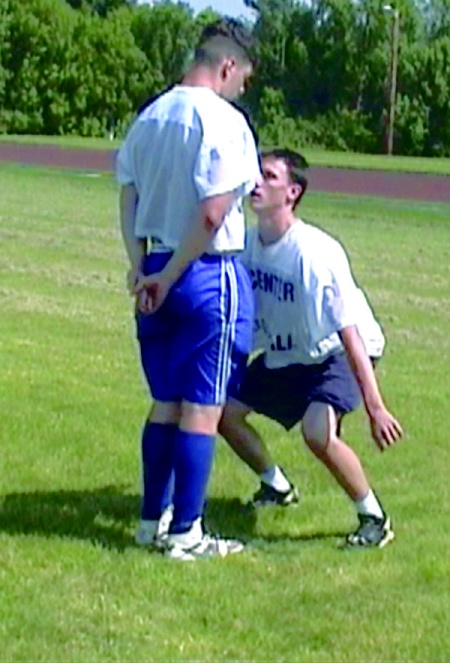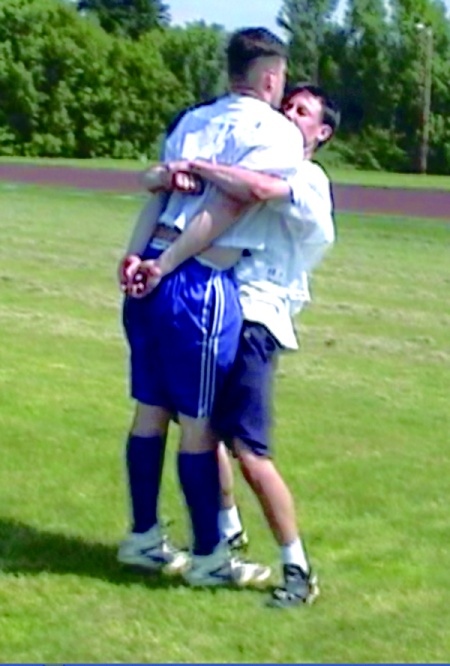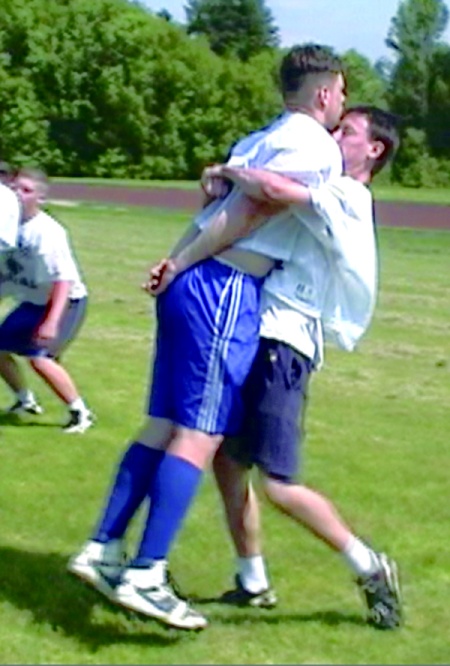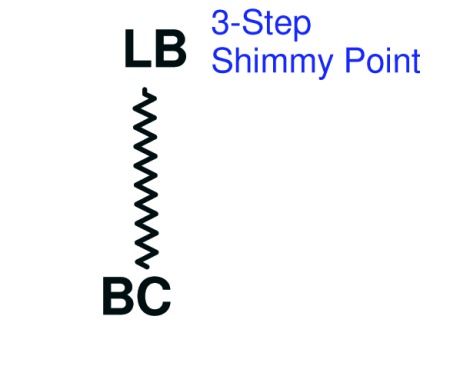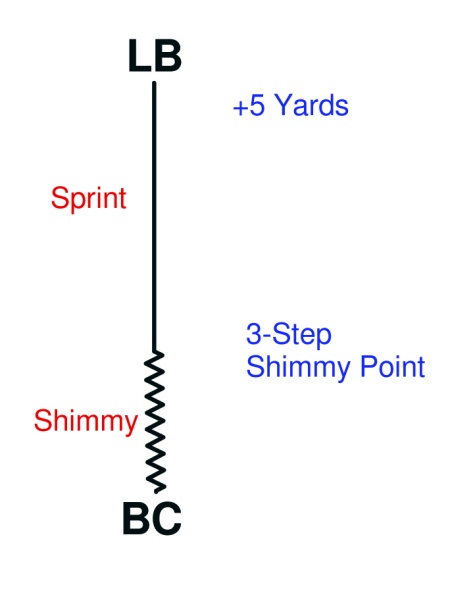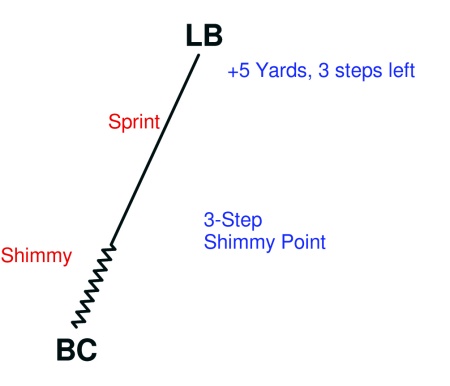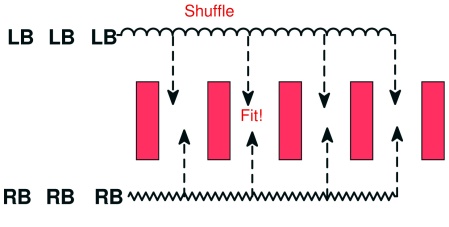Article CategoriesAFM Magazine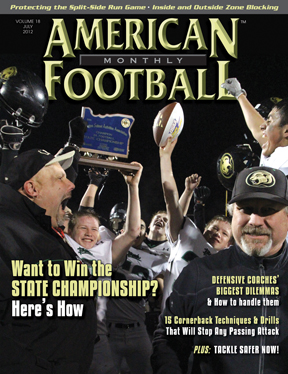
|
Safety First – Teaching safe tackling technique can reduce head and neck injuries and help protect the game’s future.by: Steve Dorsey© More from this issue In the past 35 years, two-thirds of football-related catastrophic injuries have occurred while making a tackle, according to the National Center for Catastrophic Sports Injury Research at the University of North Carolina. Most of these were caused by helmet-to-helmet contact. “This is a major problem,” said Fred Mueller, Ph.D., director of the NCCSIR, which has collected data and published annual reports on catastrophic football injuries for 48 years. Dr. Mueller said head-to-head or helmet-to-helmet contact still occurs in the game despite being prohibited since 1976. Of course, head-to-head hits are a major cause of concussions. The greater danger is that cervical spine injuries or permanent brain damage can result from helmet-to-helmet collisions. Sloppy, poorly-executed tackles using improper technique are a primary cause of many head and neck-related injuries in football. Players have a natural tendency to duck their head when they are about to deliver a tackle. If football is to me made safer, this tendency must be overcome. The head must be taken out of the game, or at least drastically reduced. There is hope. Awareness among coaches about the causes of head injuries and the need to protect against them is at an all-time high. Coaches everywhere are incorporating safer tackling techniques into their daily practices and are acutely aware of the need to “get the head out” when tackling. But there is still an ongoing need for education about how to make tackling safer. AFM asked three coaches, each of whom has developed methods to teach and drill proper tackling, to share their techniques. The common thread is getting the head out of tackling.
Photo 1.
Photo 2.
Photo 3. Coach Wyatt coached in the World Football League and currently is the coach at North Beach High School in Ocean Shores, Washington. He believes that video is a great teaching tool and has produced a video titled “Safer and Surer Tackling.” He has conducted more than 150 clinics and camps around the United States and foreign countries. He is a proponent of form tackling and said he and his staff address it every practice. He said he reserves at least 20 minutes every practice to address tackling and blocking. Coach Wyatt breaks tackling into its component parts, which he calls Hit and Fit, Lock, Lift and Drive. In the Hit position, Wyatt stresses the importance of playing with the knees bent and chest out. The Fit emphasizes putting “numbers on numbers” with the front of the shoulder pads against the ball carrier’s number, eyes to the sky looking over one or the other of the ball carrier’s shoulders. The hands are at the side and ready to strike. The Lock and Lift takes place when the tackler unloads the legs and hips and throws his arms around the ball carrier’s upper arms while driving the hips forward. “If we have locked up correctly, and if our eyes are to the sky, the jerk of the hips will lift the runner off his feet,” Wyatt said. “I know that this runs counter to some other teaching, but our thinking is that by stressing the high lock, by keeping our arms high, we reduce the likelihood of dropping the head. So rather than clubbing up from underneath the runner’s arms, we shoot high. We insist on locking so high and squeezing so tight that we tell our players to lift their shoulder pads off.” Finally, there is the Drive, which dictates that the feet keep moving to overcome the ball carrier. “At no point have we tried to take the runner down,” Wyatt said. “In fact, we seldom at any drill take a runner to the ground. We find that this immediately eliminates all the unsound shortcuts that kids take simply to get a man to the ground. That is the end result in the game, of course, but it’s not what we’re looking for in these drills.” Wyatt said that he and his staff start teaching this technique long before they put on pads. He gradually increases the tempo of the drills. “Years ago, I heard Bud Wilkinson talking to a group of middle school coaches about what he’d do if starting all over again, teaching young kids,” Wyatt said. “He had lots of good advice, and one thing that stuck with me was that he would teach tackling the way you teach swimming. You understand that the pupil is afraid and you deal with that fear by developing his confidence. And you start out slowly, teaching him the basics, and you don’t move on until he’s very confident.” Aside from tackling with “eyes to the sky,” Wyatt believes that the second most important thing for coaches to remember is not to put a young player into a high-speed drill until the player and coach both are confident in the player’s ability to do it correctly. “It’s an old teaching principle,” Wyatt said. “The test never comes before the teaching.” Wyatt said less tackling with the head down and diving at a ball carrier’s legs are aspects of the game that need to be eliminated, and it starts at the youth league level and high school. “I know hundreds of great youth league coaches who could work with me any time, but YouTube is full of clips of the other kind, youth coaches who throw little kids into survival-of-the-fittest tackling drills, brutalizing those kids for their own amusement.” Wyatt said there are two rules changes he would like to see implemented to improve the teaching of safe and effective tackling. “First, I would like to see a faster whistle (from officials),” he said. “In the interests of trying to pull the ball loose from the ball carrier, many defensive coaches are advocating holding up the runner while other defensive players pry the ball loose or punish the runner. I also would like to see batting the ball out of the runner’s grasp made illegal. Too many players and I suspect their coaches are neglecting teaching tackling in favor of teaching the strip and the bat.” “The one thing I will keep a talented kid off the field for is if he drops his head when he tackles,” Daniel said. “Beyond the safety aspect, the other thing to emphasize is to not worry about making it pretty. Just get the ball carrier down. It scares me to think that some coaches still don’t take seriously the dangers inherent in our sport.” With that said, Daniel is not overly enthused with the concept of having a governing body that regulates proper tackling techniques. “As annoying, inconvenient and undesirable as it sounds to me, I could also buy into a properly organized set of regulations being a necessary evil,” he said. Daniel said he reversed his approach to coaching tackling a few years ago. In the past, he said he would teach the finish of the tackle first and work backwards. Today, he starts with the approach. “After all, if any decent athlete can get close enough to be in the fit position, he can finish the tackle,” Daniel said. “If the approach is right, he will get the ball carrier down.” Daniel starts by having players partner up and stand side-by-side on a line. One steps off three steps to what he calls the shimmy point, then they take five more steps. The players turn, face and get into a good football position with butt down, chest and head up with the neck bowed. “We teach to show your jersey number to the ball carrier, with the hands in the holsters by your hips, never cocked back behind. Lead with one foot up, then the other. The near foot to the ball carrier will always be up.” At the start of the drill, players sprint to the shimmy point, then shimmy down and finish the drill. When the tackler is within a three-step range of the ball carrier, Daniel teaches short, choppy steps until the lead foot splits the crotch of the ball carrier. At contact, the tackler has his face mask in the chest of the ball carrier. “We tell him to have his eyes in the ‘V’ of the neck, which puts his head in a safe position.” Next, Daniel teaches angles. On an angle approach, the player will square up at the shimmy point just like in the first drill. As the player is making the tackle, Daniel wants him to shoot the hands through the ball carrier’s arm pits, or ‘knifing’ the hands through the ball, which can cause a fumble. He emphasizes to explode the hips. He wants the tackler to climb the body with the hands and grab high cloth. Run the knees high and wide through the tackle and keep the feet moving until the ball carrier is down. “With knees high and wide, outside the frame of the ball carrier, we are preventing his ability to spin out of the tackle,” Daniel said. “Take your time teaching tackling. Be organized in teaching tackling progression.” He suggests spending 15-30 minutes on tackling in your early practices (See Diagrams 1-3 – tackle progression).
Diagram 1.
Diagram 2.
Diagram 3. Daniel also teaches the Eye Opener Drill designed to improve tackling technique (Diagram 4). The defender stands facing a running back who is turned sideways. The defender is slightly behind the ball carrier (on his backside hip) to keep from over-running the tackle. The ball carrier begins jogging at about 70% as the defender shuffles with him, maintaining his position. The ball carrier then picks any hole he wants and turns square into that hole. He sprints forward as the defender attacks and fits up for the tackle.
Diagram 4. The key points for the drill are to explode the hips, knife the hands through the ball, and grab high cloth on the ball carrier. Emphasize the head always being up, chin in the chest, and eyes on the V of the neck. Coach Hosea is a former defensive back at UCLA who played three years in the Canadian Football League. When his young son approached him about going out for a youth football league about 15 years ago, Hosea wanted to make sure that his son was correctly educated about proper tackling techniques, which led to him become a youth league coach. He subsequently opened a tackling academy and instructional camp in California six years ago. Hosea believes that it’s important to educate young players on what causes the head to go down just before delivering a tackle. He said he hears everyone talking about head injury awareness, so he decided to do something about it. He has developed a program that he calls BIG HITTS. The acronym stands for Bringing Intelligence to the Game through the High Intensity Tackle Training System. Part of the program includes instruction on Hosea’s proper tackling techniques. Hosea takes a somewhat unconventional approach to instill in his pupils the habit of not lowering their heads when making a tackle. Players line up on their knees and lunge forward onto pads with their arms behind their backs. As they are lunging, they are instructed to call out the number of fingers a coach raises to prove that their heads are looking up. The next drill helps ensure that players stay low and tackle with the proper form – knees bent, butt out, chest up, bending the spine to force the chin and eyes up. Arms remain at the player’s side until just before impact, with the hips and shoulders thrusting up the arms into the ball carrier. Hosea’s technique does not instruct players to wrap, but rather rip the arms under the ball carrier’s arm pits. He calls it the rip-and-shoot technique that delivers power through the legs, hips and shoulders. The teaching tool Hosea uses is called Dip-‘n-Rip, which includes horizontal bars held about five feet off the ground that players must run under full speed before hitting tackling dummies. “The arms and hips control the head,” Hosea said. “The tackle is generated through the legs and the hips transfer that power. It’s physics, simple as that. If you wrap, your hips go back and your head is going to go down. We have to eliminate wrapping from our vocabulary. It’s extremely important never to drop the chin. You need to see what you’re hitting all the time.” The bottom line, Hosea urges his students, is you never want to initiate contact with the crown of the helmet, which comes from leading with the head. “Taking crown-first impacts out of the game will save the game,” Hosea said. “If not, the game will die because the risks will clearly outweigh the reward.” |
|
| HOME |
MAGAZINE |
SUBSCRIBE | ONLINE COLUMNISTS | COACHING VIDEOS |
Copyright 2025, AmericanFootballMonthly.com
All Rights Reserved


